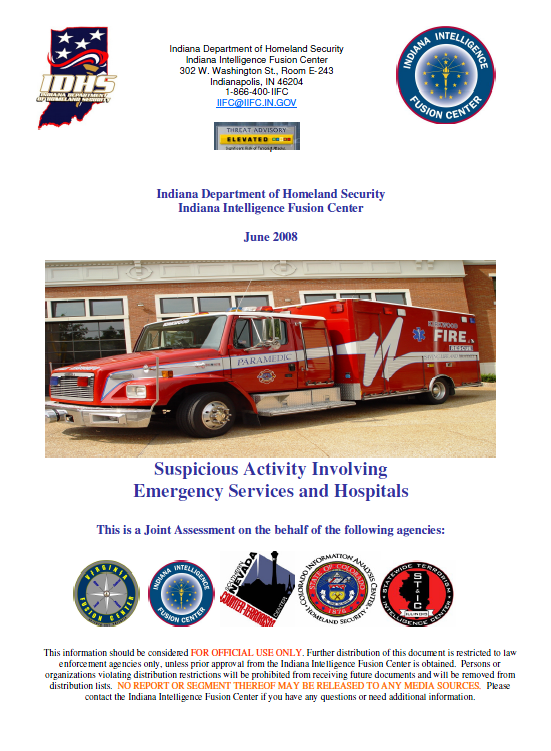Indiana Department of Homeland Security/Indiana Intelligence Fusion Center Suspicious Activity Involving Emergency Services and Hospitals
- 6 pages
- June 2008
(U//FOUO) The purpose of this assessment is to provide situational awareness of suspicious incidents involving the ESS, as reported by local public safety officials and State and Local Fusion Centers in Indiana, Virginia, Colorado, Nevada, and Illinois.
Key Findings
(U//FOUO) The IIFC assesses there to be no specific foreign or domestic terrorism threat related to the ESS, to include hospitals, within the jurisdictions of contributing State and Local Fusion Centers.
(U//FOUO) Pre-operational surveillance of emergency service facilities, hospitals and fire stations could provide an adversary with emergency procedures and protocols, response time and capabilities, and facilitate access to emergency service uniforms and equipment.
(U//FOUO) Attacks on ESS personnel, physical assets, and communication/cyber systems are serious threats to the continuity of operations.
(U//FOUO) Enrollment into an Emergency Medical Technician (EMT) course provides an understanding of emergency procedures and protocols that a terrorist may use to learn about emergency response vulnerabilities.
…
(U//FOUO) Based on previous assessments, and observed terrorist attacks abroad, the IIFC concludes there are a number of situations where the ESS could be susceptible to an attack within the Homeland.
(U//FOUO) Past intelligence reports indicate that al Qaeda and other terror networks may try to convince/solicit U.S. hospitals and medical clinics to help them obtain B-2 visas to gain entry into the United States as medical patients.
(U//FOUO) Past assessments indicate the opening stages of terrorist attacks may be
directed at U.S. hospitals.
- (U//FOUO A May 20, 2008 FBI Intelligence Bulletin reported an attempted theft of a radiological element (Cesium-137) at an identified U.S. hospital. Although the Cesium-137 can pose a significant exposure hazard, an insufficient quantity was involved to constitute an acute radiation hazard.
- (U//FOUO) A June 09, 2004 New Jersey Intelligence Bulletin reported hospitals should be concerned with terrorists attempt to take over a hospital in order to create a hostage situation. Similar plans have been found in an al-Qaeda training video.
- (U//FOUO) A June 09, 2004 New Jersey Intelligence Bulletin reported terrorists could launch an assault on a hospital as part of a coordinated terrorist attack on another sector, such as public transportation. The incapacitation of a hospital near the site of another attack would greatly strain health resources and force those injured in the original attack to be rerouted to other area hospitals.
- (U//FOUO) Hospitals could be a primary or secondary target, allowing terrorists to harm first responders, disrupt rescue efforts and generally increase panic. Any inclusion of the healthcare system in a terrorist attack would greatly increase its impact and could seriously impede emergency responders.
- (U//FOUO) Terrorists could convert an ambulance into a vehicle-borne improvised explosive devise (VBIED).
(U//FOUO) Homegrown terrorists and foreign terrorists living in the United States could try to establish themselves as legitimate persons in the community by holding important jobs such as doctors, paramedics, nurses, or EMTs.
(U//FOUO) Terrorists may use the aforementioned professions to gain access to critical infrastructures, large events, or other sensitive areas in hopes of carrying out a large-scale attack producing mass casualties.
(U//FOUO) Using stolen emergency vehicles (i.e. emergency medical services, fire, and police vehicles), terrorists could impersonate and blend in with first responders for the purpose of conducting a VBIED attack.

